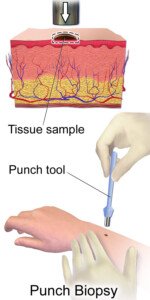When a dermapathologist views mole cells under a microscope, how long does it take them to identify if it’s melanoma or benign?
Your doctor will tell you it takes a week to two weeks for “the results to come back.” Sometimes the doctor will say it’ll take “a couple days.”
But most of that time is tied up in processing. What about the actual identification by the pathologist or a pathologist who specializes in skin samples—the dermatopathologist?
“Once a pathologist sees the slide or slides from the biopsy, the time to diagnosis could be almost instant — 10 minutes to review and write up a report,” says Jena Martin, MD, a board certified anatomic and dermatopathologist, trained at Mayo Clinic Pathology, having practiced in the Minneapolis area for over 10 years.
“However, other steps to scrutinize the tissue might be needed,” continues Dr. Martin.
“For example, we can get deeper histologic levels to make sure we are seeing all there is. Or, we might need special stains (called immunohistochemical stains).
“These other steps could add an entire day to the diagnosis, because labs perform those tests once a day (24-36 hours).
“Rarely, some atypical pigmented lesions are especially difficult for the pathologist or dermatopathologist, and the case is sent to an outside facility with nationally recognized pathologists. This could add a week or more to the diagnosis.”
 Dr. Martin trained at Mayo Clinic Pathology and has been practicing for 20+ years and is with Dermatology Consultants in St. Paul, MN.
Dr. Martin trained at Mayo Clinic Pathology and has been practicing for 20+ years and is with Dermatology Consultants in St. Paul, MN.
 Lorra Garrick has been covering medical, fitness and cybersecurity topics for many years, having written thousands of articles for print magazines and websites, including as a ghostwriter. She’s also a former ACE-certified personal trainer.
Lorra Garrick has been covering medical, fitness and cybersecurity topics for many years, having written thousands of articles for print magazines and websites, including as a ghostwriter. She’s also a former ACE-certified personal trainer.
.



























